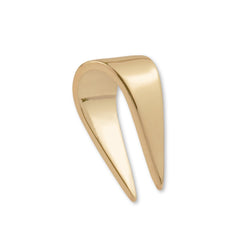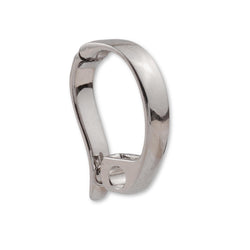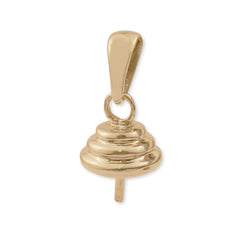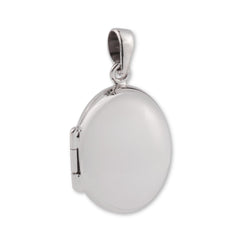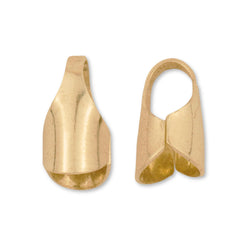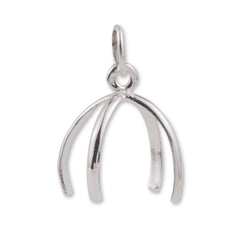Halsband fynd
Halsband & hängsmycke Hittade Australien
Dyk djupare in i vår omfattande halsbandskollektion, där varje del är ett bevis på kvalitet och mångsidighet. Från elegansen hos våra hängsmycken i Sterling Silver till hållbarheten hos våra 18 karat guldkåpor, vi tillgodoser alla juvelerares behov.
Hantverkare som vill ge en personlig touch till sina skapelser kommer att tycka att våra Enhancer-hängen och Pearl Cup-hängen är särskilt lockande. Dessa komponenter är inte bara tillbehör; de är grunden för tidlösa smycken.
Oavsett om du är en professionell juvelerare eller en gör-det-själv-smyckenaficion, erbjuder vårt utbud av borgen, ändlock och hängsmycken i ädelmetaller som gult guld, roséguld och vitguld oändliga möjligheter.
Vanliga frågor
- Byglar: Dessa är kopplingar som används för att fästa hängen till en halsbandskedja eller sladd. De finns i olika former och storlekar och kan variera från enkla slingor till mer dekorativa stilar.
- Förstärkare: På samma sätt som byglar men ofta med en spännmekanism, gör förstärkare det möjligt att enkelt lägga till eller byta hängen på ett halsband. De är idealiska för mångsidighet och kan användas med en mängd olika halsbandsstilar.
- Pärlkoppshängen: Dessa är specialiserade inställningar utformade för att hålla pärlor eller runda pärlor. De har en kupad bas med en pinne för att säkra pärlan på plats.
- Medaljoner: Medaljoner är en typ av hängsmycke som kan öppnas för att avslöja ett utrymme inuti för att förvara bilder eller andra små minnessaker. De finns i olika utföranden, från klassiskt till modernt.
- Ändkapslar: Används för att avsluta ändarna på halsband, med en mängd olika stilar beroende på om din slutsnöre eller metallkedja. Ändstycken ger en snygg och professionell finish till smycket.
- Hängeinställningar: Dessa är delarna av ett halsband som innehåller en ädelsten, kristall eller andra dekorativa element. De finns i olika former, som stiftinställningar, raminställningar eller snapin-inställningar, vilket möjliggör mångsidighet beroende på stil och typ av sten som sätts.
Dessa fynd är viktiga för att skapa en rad halsbandsstilar och -designer, vilket möjliggör anpassning och personalisering av smycken.
Beroende på önskad stil och estetik du är ute efter, här är en lista över alla komponenter du kan behöva:
- Kedja eller snöre: Detta är huvudstrukturen i halsbandet, som kan variera i längd, material och stil. Alternativen inkluderar metallkedjor, lädersnören eller syntetiska material.
- Spänne: Mekanismen som används för att öppna och stänga halsbandet. Vanliga typer inkluderar hummerspännen, fjäderringspännen, växlande spännen och magnetiska spännen.
- Hoppringar: Små metallringar som används för att fästa spännet på kedjan eller snöret och används ofta för att lägga till andra komponenter till halsbandet.
- Hängen eller berlocker: Dekorativa element som hänger från halsbandet. De kan fästas direkt på kedjan eller genom andra fynd som borgen.
- Byglar: Anslutningar som gör att du kan fästa ett hänge eller berlock på kedjan, vilket ger ett sätt för den att hänga ordentligt.
- Förstärkare: Spännliknande komponenter som gör att du lättare kan lägga till eller byta ut hängen på ett halsband.
- Pärlor och distanspärlor: Används för att lägga till dekoration och stil till halsbandet. Distanspärlor används specifikt för att separera andra pärlor eller komponenter jämnt.
- Tråd-, snöre- eller pärltråd: Beroende på typen av halsband kan du behöva flexibel pärltråd, nylontråd eller andra strängmaterial.
- Ändskydd: Används för att avsluta ändarna på halsband med tråd eller flertråd, vilket ger en snygg och säker stängning.
- Hänginställningar: Om din design inkluderar sättningsstenar eller kristaller, behöver du hängande inställningar som raminställningar, stiftinställningar etc.
- Verktyg: Grundläggande verktyg för smycketillverkning som tång (nålsnäsa, rund näsa, platt näsa), trådskärare och eventuellt ett pressverktyg.
- Bygel: Fäst eller löd fast bygeln på hängsmycken och skjut den sedan på din kedja eller sladd. Bails ger ett enkelt sätt att lägga till eller byta ut hängen på ett halsband.
- Förstärkare: Dessa kan fästas på en kedja eller sladd, så att du kan lägga till eller byta hängen utan att behöva skjuta dem över änden av halsbandet.
- Pärlkoppshängen: Sätt in pärlan eller pärlan på pinnen på pärlkoppshänget, säkra den på plats, ofta med klister.
- Medaljoner: Kan fästas direkt på kedjan eller genom en bygel. De öppnas för att hålla små minnessaker eller foton.
- Ändhylsor: Används för att avsluta ändarna på flertrådiga eller snörade halsband. Fäst dem med löd, lim eller genom att krympa, beroende på deras design.
- Hänginställningar: Ställ in din valda sten eller dekorativa element i inställningen. Detta kan innebära att elementet snäpps på plats eller att använda en inställningsteknik som stift- eller raminställning.
Pendant fittings are components used to attach pendants or charms to necklaces, bracelets, or earrings. They provide a secure connection between the jewellery piece and the chain or cord. Pendant fittings come in various styles, including bails, bezel settings, and prong settings, allowing you to showcase gemstones, pearls, or other decorative elements in your designs.
Choosing the right pendant fitting depends on the style, size, and weight of the pendant, as well as the type of chain or cord used. For heavy pendants, opt for sturdy bails like snap lock or pinch bails. If you’re setting a gemstone, consider using bezel or claw settings for a secure fit. For a minimalist look, choose a simple bail or loop fitting that complements the pendant’s design.
Using recycled metals in jewellery making helps reduce the environmental impact by minimizing the need for new mining. Recycled metals, such as recycled sterling silver or gold, maintain the same quality and durability as newly mined metals, making them an ethical choice for jewellery makers. Additionally, consumers increasingly prefer eco-friendly and sustainable products, which can enhance the appeal of your jewellery designs.
Essential tools for working with pendant fittings include jeweller’s pliers, tweezers, a magnifying glass, and a jeweller’s loupe. For setting gemstones, you’ll need a prong pusher or bezel roller, depending on the setting type. A fine-tipped glue applicator is useful for glue-on fittings, while a polishing cloth helps maintain the finish of your fittings.
To care for and maintain jewellery with sterling silver fittings, store the pieces in a cool, dry place, preferably in anti-tarnish pouches or a jewellery box. Clean sterling silver regularly with a soft polishing cloth to remove tarnish and restore shine. Avoid exposing silver jewellery to harsh chemicals, moisture, and prolonged sunlight to prevent tarnishing.
Yes, pendant fittings can be used in both modern and vintage-inspired designs. Modern designs often feature sleek, minimalistic fittings like simple bails or bezel settings. For vintage-inspired designs, consider using ornate, detailed bails or settings that echo antique styles. The choice of metal finish, such as aged silver or rose gold, can also enhance the vintage look.
To create a layered necklace design, choose pendant fittings of varying lengths and styles that complement each other. Start with a central focal pendant on a longer chain and layer additional pendants on shorter chains. Mix different shapes, sizes, and metal finishes to add depth and interest to the design. Ensure the chains have different textures and thicknesses to avoid tangling.
Yes, pendant fittings can be customized for bespoke jewellery pieces. Many jewellers offer custom fittings tailored to the specific design, gemstone size, and metal preferences of the client. Custom fittings allow for greater creativity and personalization, ensuring that the final piece is unique and perfectly suited to the wearer’s taste.
To achieve a professional finish in your jewellery designs, focus on precision and attention to detail. Use high-quality materials and tools, ensure all connections are secure, and take care to avoid scratches or blemishes on the metal. Polishing the final piece to a high shine and ensuring that all elements are aligned and symmetrical will contribute to a polished, professional look.
Yes, pendant fittings are suitable for beginners in jewellery making. Many pendant fittings, such as glue-on bails or simple loop fittings, are easy to use and require minimal tools or expertise. Beginners can start with basic projects using these fittings and gradually progress to more complex designs as they gain experience and confidence.
When selecting components for a jewellery project, consider the style, durability, and compatibility of the materials. Ensure the metal types match or complement each other, and choose components that suit the design’s aesthetic, whether modern, vintage, or minimalist. Also, consider the wearer's preferences, such as metal allergies, and the overall functionality of the piece.
To prevent tarnish on sterling silver jewellery findings, store them in a dry, airtight container, preferably with anti-tarnish strips. Regularly clean the findings with a soft polishing cloth to remove any surface oxidation. Avoid exposing the silver to chemicals, moisture, and prolonged sunlight, as these can accelerate tarnishing.
To mix and match different metals in a jewellery design, choose metals that complement each other, such as gold and silver, or rose gold and platinum. Use a unifying element, such as consistent shapes or textures, to tie the design together. Balance the use of each metal to create a cohesive look, and ensure that the different metals are in harmony with the overall style.
For a minimalist jewellery design, choose simple, understated fittings that do not overpower the piece. Opt for sleek bails, small bezel settings, or discreet loops that allow the focus to remain on the pendant or gemstone. The use of clean lines, polished finishes, and neutral metal tones like silver or white gold can enhance the minimalist aesthetic.
To securely attach a pearl cup pendant to a necklace, first, mount the pearl onto the peg of the cup using jewellery adhesive. Ensure the pearl is firmly set and allow the adhesive to cure fully. Once the pearl is secure, attach the pendant to the necklace chain using a bail or jump ring, making sure the connection is tight and secure.
To set a gemstone in a claw pendant setting, place the stone into the setting and gently push the prongs over the stone using a prong pusher or jeweller's pliers. Ensure that the prongs are evenly spaced and securely hold the stone in place. Check that the stone is level and adjust the prongs as needed to ensure a secure and professional finish.
Yes, pearl cup pendants can be used with gemstones other than pearls, provided the gemstone is drilled to fit the peg of the cup. Gemstones like opals, turquoise, and other soft stones work well with pearl cup settings. Ensure the gemstone is securely mounted with adhesive and that it fits snugly onto the peg.
Bezel cup pendant settings offer several advantages for cabochons. They provide a secure and protective setting that holds the stone in place, preventing it from falling out. Bezel settings also create a smooth, polished edge around the cabochon, enhancing its appearance and giving the jewellery a sleek, finished look.
When choosing a bail for a heavy pendant, opt for a sturdy, durable bail such as a snap lock or pinch bail. These types of bails provide a secure connection and can support the weight of the pendant without risk of breaking or detaching. Ensure the bail size matches the thickness of the chain or cord and that it complements the pendant’s design.
Yes, enhancer pendants can be used to convert charms into pendants. The hinge or loop mechanism of an enhancer pendant allows it to easily attach to a charm, turning it into a pendant that can be worn on a necklace. This versatility makes enhancer pendants a popular choice for creating interchangeable jewellery pieces.
A pearl cup setting is designed specifically for mounting drilled pearls or round gemstones by fitting the stone onto a peg within the cup. In contrast, a bezel setting encircles the entire gemstone, securing it within a metal rim. Bezel settings are typically used for cabochons or flat-back stones, while pearl cups are ideal for round, drilled stones like pearls.

